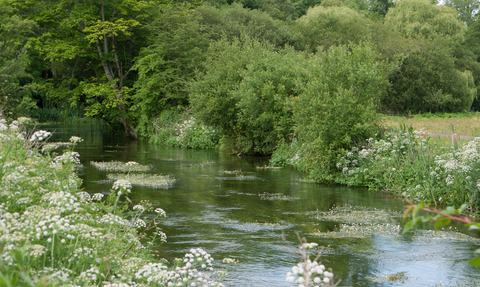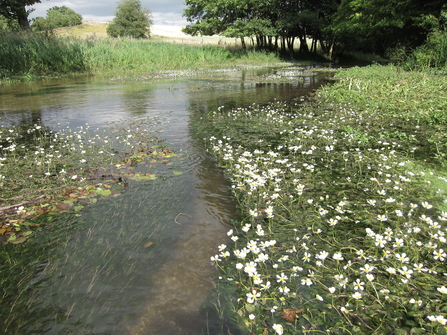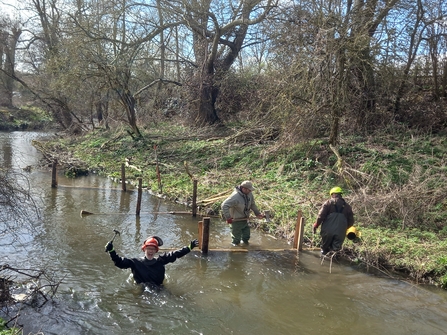
Our Position on Chalk Rivers
Why are Chalk Rivers Special?
Chalk rivers are one of the rarest habitats on earth. There are only 260 chalk rivers in the entire world and England is home to 85% of these vital waterways. In Hertfordshire and Middlesex we are custodians of 10% of this precious global resource.
In their natural state these rivers are extremely wildlife rich and provide lots of ecosystem benefits for people such as clean water, carbon capture, flood protection and climate resilience. They have even been described as Britain’s equivalent to tropical rainforest due to their rarity and for the diversity of life that they support.
Our chalk rivers should be fast flowing, with clean plentiful water rising out of an unpolluted aquifer. The head of the river would move naturally with the seasons, creating a diverse mix of permanently wet and temporarily dry sections that support a unique variety of plants and animals.
Flowing across natural, undeveloped floodplains and weaving through habitats like wet woodland, reedbed and marshy grassland, these rivers would add dynamism to the landscape, providing an ever-evolving space for wildlife to move and migrate.

Water vole © Terry Whittaker/2020VISION
The Current Condition of our Chalk Rivers
Unfortunately, less than a quarter of our chalk rivers are in good condition and none of these are within Hertfordshire. This is a result of combined human pressures impacting the way our chalk streams naturally flow and function. The biggest threats are to flow, quality and physical habitat – the trinity of ecological health for a pristine chalk river. In our region, the main causes of decline are due to:
Pollution
Pollution from towns and cities, road run-off, agricultural activities and sewage are adding more pressure on chalk river systems. Low water levels cause pollutants to concentrate, further reducing the quality of water left in the system and causing algal blooms, oxygen crashes and direct toxicity to aquatic life. This affects 30% of our chalk rivers in Hertfordshire.
Abstraction
Over 60% of water for public and commercial use is abstracted from the ground and directly from rivers. This means large volumes of water are being taken out of the system and more quickly than they can naturally be replaced, causing a deficit in groundwater levels that supply the rivers. This affects 39% of our chalk rivers in Hertfordshire.
Modification
There are over 300 fords, weirs and culverts preventing fish passage across the River Lea Catchment alone! A healthy chalk river needs three things: clean water, lots of it, flowing through good physical habitat. Our rivers have been damned up by weirs and fords, their beds and gradients dredged out, their courses artificially altered, their floodplains drained and soils compacted, invasive species introduced that erode banks and predate native wildlife. All this human activity has stopped our rivers from functioning properly. This affects 100% of our chalk rivers.
Environmental and Climate Change
The South East has one of the highest water consumption rates in the country, is one of the driest UK regions and its population is increasing, putting consistent pressure on our chalk river systems. Over the next 50 years, climate change is also predicted to reduce available water supply across this area significantly. As these issues combine and public demand for water continues to rise, so does the threat to our chalk rivers.

Our Vision for Chalk Rivers
Our vision for chalk rivers is simple – clean, plentiful water flowing through natural habitat that supports its characteristic wildlife. We want to see:
- Pollution of freshwaters stopped.
- Habitat conditions improved and maintained to safeguard biodiversity.
- Catchments restored and protected.
- Water used wisely and valued by society.
To help achieve our vision for chalk rivers and wetlands, we believe that action is required across all levels of society. Our Top Priorities are:
- Bespoke legal protections for all our chalk rivers that protect them from over-abstraction and pollution and drives investment by water companies and other sectors.
- Environmental regulators adequately resourced and funded to enforce current legislation and hold polluters to account (with polluters paying penalties that reflect the true environmental damage being caused).
- Targets to put our rivers into good ecological condition brought forward and made SMART.
- Water companies and developers mandated to invest in necessary infrastructure to keep pace with population growth and climate change, rapidly scaling up and prioritizing the use of nature-based solutions over hard infrastructure where appropriate.
- Sufficient budget to enable landholders to adopt water-friendly farming practices across chalk river catchments, to support landholders to reduce their impacts on rivers and restore vital habitats.
- Consumption of water is reduced to meet (or surpass) the national target for water stressed regions of 110 litres per person per day.
You can read our full list of actions to support our vision here.
What is Herts & Middlesex Wildlife Trust Doing to Improve our Chalk Rivers?
The Trust has been working since 2012 to raise awareness of these issues and deliver improvements. Here are just some of the ways we’re working regionally, and nationally, to protect and restore our chalk rivers:
- We’re removing weirs and barriers to enable fish passage; restoring chalk stream habitats and reconnecting them to their floodplain - undoing the damage caused by dredging and milling; reintroducing lost, native species such as critically endangered Water Vole and eradicating invasive non-native species which limit recovery of our river systems.
- We’re supporting landowners to deliver restoration work.
- We train citizen scientists to monitor our rivers and target remedial action.
- We coordinate a partnership network of 350+people, bringing together knowledge and multi-sector working to overcome some of the biggest threats to chalk stream health.
- We carry out policy and advocacy work, linking into that of the national Wildlife Trust and Blueprint for Water.
- We comment on Government water policy and statutory plans, liaise with the water Regulators (EA, DEFRA, OFWAT) on key issues in our catchment, and respond to consultations shaping water company business plans for chalk streams.
We Believe in Working in Partnership to Find Solutions
The issues facing our chalk rivers are complicated, interlinked and not governed by just one sector or industry. We believe that working together to find overlaying solutions that meet everyone’s goals - like clean, reliable water, for the environment, people, and businesses - and supporting action for chalk streams on the ground, is the most effective approach.
This means working alongside sectors to find nature-based solutions where there may be controversial issues – whilst retaining our autonomy to challenge unacceptable or non-compliant activities.
For example, we work with water companies in different ways. We provide input to their emerging plans and strategies based on our knowledge and evidence on the ground. This helps to channel investment and shape their priorities to best meet the needs of the catchment with limited resources.
We receive funding occasionally to partner on specific river-recovery projects, such as reintroducing native species or developing citizen science programmes that will identify what/where the critical issues are and develop catchment plans to mitigate these.
We advocate for stronger environmental ambitions and highlight what isn’t working, feeding into developing plans and policy at a National and Regional level. We have hard conversations on behalf of the catchment partnership network, challenging what we feel needs to shift to make our rivers better and offering support and partnership solutions for how to do this.
By working together, many improvements already delivered can be built on. The path to good condition has finally found consensus via the Chalk Stream Strategy 2021 and more resources are being channelled into recovery than ever before - though there’s still a long way to go.
We need momentum and resources to continue to build so that the next decade for our chalk rivers can be a brighter one, with swifter delivery of jointly agreed recovery plans so we can see them start to thrive once more.

Questions We’re Often Asked
Why are you working with the water companies?
Water flow and quality issues are not just caused by the water companies. We do, however, agree that the way water is supplied and treated by the companies must adapt quickly and be more sustainable, and we advocate for this on many levels.
Land use, domestic water uses and misconnected homes/septic tanks, roads and infrastructure run-off, all contribute to poor flow and quality. If we decided we wouldn’t work with any sector polluting or abstracting from the rivers, then we wouldn’t be working with anyone – we all use and dispose of water in different ways, therefore we all contribute.
We do not think silo working is sustainable and it will not lead to change. By working with the water companies, building trust around catchment data, shared solutions and combining resources to deliver improvements, we have shown change is possible. The Chalk Stream Strategy is a culmination of working together in practice. This is the first time a fully agreed on strategy has been published – and it is only by working together was this made possible. we have a framework, now we need to deliver it jointly.
How big a problem is sewage pollution in the region?
There has been an upsurge in public interest in rivers following the release of national data since 2020 around sewage pollution from storm discharges. Whilst we recognise this is a significant issue that must be addressed, it has skewed the focus away from some of the other problems, which are just as, if not more, important in chalk stream recovery. Storm surges only account for 4% of the reasons for failure, whereas, for example, roads contribute to 30% of failures.
So, whilst we appreciate the efforts going into raising this as an issue and it has brought a needed sense of urgency to the topic of chalk streams, solving this problem alone will not bring our chalk rivers back from the brink.
Why are you bothering with river habitat restoration projects when the water is not clean and the flows are low?
A healthy chalk river needs three things: clean water, lots of it, flowing through good physical habitat. That means river habitat that supports natural processes like erosion and deposition, varied flow patterns and depths, floodplain connection and associated habitats like wet woodland or fen.
Our rivers have been damned up by weirs and fords, their beds and gradients dredged out as part of archaic flood defence tactics, perched to the side of the floodplain for milling and road building, their floodplains drained and soils compacted, invasive species introduced that erode banks and predate native wildlife.
All this human activity has stopped our rivers from functioning properly. They don’t flow fast and oxygenate. They are over deep with no energy to move sediment. Pollution is trapped in short stretches between weirs, between weirs, between weirs. Fish can’t move and escape. The river can’t breach into the floodplain at times of flood. Drought resilience is limited.
With all the good quality water in the world back in our rivers, if it is flowing through degraded physical habitat, there will always be a limit to the recovery of our chalk rivers and the wildlife that they can support.
Physical habitat is one of the more instant issues we can fix. It gives us rapid results while we are waiting for years for new reservoirs to come online or sewage works to be upgraded. Habitat restoration is where our expertise as a Wildlife Trust lies. That is why we will continue to restore as many kilometres and reconnect as many hectares of floodplain as possible. The data we collect on our projects shows we are doing the right thing.
Can the Trust do more to support our chalk rivers?
We are involved in a large range of activities related to protecting and improving our rivers. Resourcing dictates how much we can achieve. We have a small team running our Living Rivers programme, but where we can we bring in external funding to expand our resources or channel it through the partnership to achieve more.
We always have a rolling set of capital projects in development alongside our core catchment hosting, advocacy, and policy work. To date we have developed plans for restoring over 25km of chalk river habitat (and working towards delivering it all), as well as eradicate mink from the catchment, treat 36 hectares of plant INNS and train over 200 people in citizen science monitoring.
There will always be more to do and we will continue to seek resources and funding to enable us to deliver work on behalf of the catchment partnership and Hertfordshire's chalk rivers.
